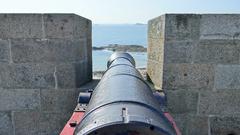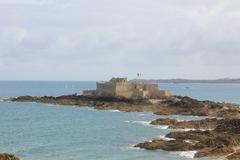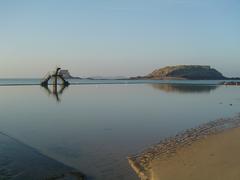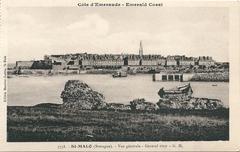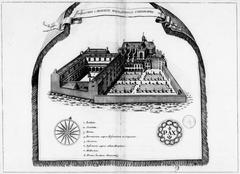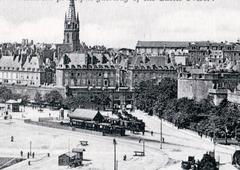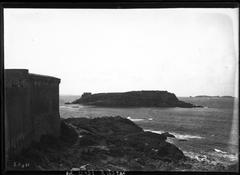Guide to Visiting Château de la Briantais in Saint-Malo, France
Publication Date: 24/07/2024
Introduction to Château de la Briantais
Nestled in the picturesque town of Saint-Malo, France, the Château de la Briantais stands as a testament to the region’s rich history and architectural grandeur. Built in 1666 by the Pointel family, this château has witnessed centuries of maritime activity and cultural evolution, making it a significant historical landmark (Wikipedia). Over the years, it has been owned by several influential families, each contributing to its architectural and cultural transformation. Today, it is a vibrant cultural hub hosting various events, exhibitions, and concerts (Saint-Malo). This comprehensive guide provides detailed information on the château’s history, architectural significance, visitor tips, and much more, ensuring you make the most of your visit.
Contents Overview
- Introduction
- History of Château de la Briantais
- Early Beginnings and Construction
- Ownership Changes and Architectural Evolution
- The 19th Century Transformation
- 20th Century Developments
- Recent History and Current Use
- Visitor Information
- Visiting Hours and Tickets
- Travel Tips
- Architectural Significance
- The Park and Gardens
- Cultural and Historical Events
- FAQ
- Conclusion
History of Château de la Briantais
Early Beginnings and Construction
The Château de la Briantais, located in Saint-Malo, France, has a rich history that dates back to the 17th century. The original manor on the site was constructed in 1666 by the Pointel family, a prominent family of shipowners and merchants. The manor was strategically built to oversee the maritime traffic in the bay of Saint-Malo, providing the family with a vantage point to monitor their fleet (Wikipedia).
Ownership Changes and Architectural Evolution
In 1770, the estate was sold to the Picot family, another influential family of shipowners. The Picots made significant modifications to the manor, including the addition of a chapel in 1778. However, the most substantial changes came in the 19th century when the property was acquired by Eugène Sully-Brunet. Between 1850 and 1864, Sully-Brunet commissioned the construction of the current château, replacing the original manor but not on the exact same location (Visit Places France).
The 19th Century Transformation
The new château was designed in a classical architectural style, characterized by its elegant symmetry and detailed facades. The construction included a small bell tower reminiscent of the one on the Saint-Malo town hall, providing an effective observation post over the estuary. The château’s interiors were equally opulent, featuring period furnishings, tapestries, and an exquisite art collection (Wikipedia).
20th Century Developments
In 1888, the château was purchased by Charles Émile La Chambre and his family, who added two lateral wings to the building just before 1900. Guy La Chambre, a former minister and mayor of Saint-Malo, inherited the property but, lacking heirs, donated it to the Diocesan Association of Rennes in 1975. The association used the château as a cultural and spiritual center until the maintenance costs became too burdensome, leading to its sale to the city of Saint-Malo in 1999 (Wikipedia).
Recent History and Current Use
Since its acquisition by the city, the Château de la Briantais has been open to the public during the day. The château and its surrounding park have become a venue for various cultural events, including jazz and classical music concerts, art exhibitions, and the International Poetic Encounters of Brittany. The park also hosts the Saint-Malo flower market every May (Visit Places France).
Visitor Information
Visiting Hours and Tickets
- Opening Hours: The Château de la Briantais and its park are open to visitors daily from 9 AM to 7 PM. It is advisable to check the official website for any changes in opening hours.
- Ticket Prices: Admission to the park is free. However, guided tours of the château are available for a fee. Please check the official website for the most current ticket prices.
- Cultural Events: The château regularly hosts various cultural events. Check the schedule on the official website for concerts, art exhibitions, and other events.
Travel Tips
- Guided Tours: Consider joining a guided tour to gain deeper insights into the château’s history and architectural significance.
- Picnic Areas: The park offers several picnic areas where visitors can relax and enjoy the scenic views.
- Accessibility: The park’s serpentine paths are accessible, but some areas may be challenging for visitors with mobility issues. It is recommended to wear comfortable walking shoes.
- Nearby Attractions: Don’t miss the opportunity to explore other historical sites in Saint-Malo, such as the Saint-Malo Cathedral and the Fort National.
Architectural Significance
The Château de la Briantais is a prime example of 19th-century classical architecture. Its design reflects the wealth and refined tastes of its former inhabitants. The château’s bell tower, reminiscent of the Saint-Malo town hall, and its strategic location overlooking the estuary highlight its historical significance as a maritime observation point (Wikipedia).
The Park and Gardens
The château is set within a 27-hectare park designed in the English landscape style. The park features a variety of trees, including Aleppo pines, stone pines, holm oaks, cypresses, olive trees, acacias, eucalyptus trees, common ash trees, poplars, tipu trees, and Judas trees. The park’s design includes serpentine paths that ascend and descend the terrain, connecting various viewpoints that offer magnificent panoramic views of Saint-Malo and the surrounding estuary (Visit Places France).
Cultural and Historical Events
The Château de la Briantais has played host to numerous cultural and historical events over the years. These events have included concerts, art exhibitions, and poetry readings, making the château a vibrant cultural hub in Saint-Malo. The park’s serene environment and historical significance make it an ideal location for these events, attracting both locals and tourists alike (Wikipedia).
FAQ
Q: What are the opening hours of Château de la Briantais? A: The château and park are open daily from 9 AM to 7 PM. Please check the official website for any updates on opening hours.
Q: How much are tickets to Château de la Briantais? A: Admission to the park is free. Guided tours of the château are available for a fee. Check the official website for current ticket prices.
Q: Are there guided tours available? A: Yes, guided tours are available and highly recommended for a deeper understanding of the château’s history and architecture.
Q: What events are held at Château de la Briantais? A: The château hosts a variety of cultural events, including jazz and classical music concerts, art exhibitions, and the International Poetic Encounters of Brittany.
Conclusion
The Château de la Briantais stands as a testament to the rich history and cultural heritage of Saint-Malo. Its architectural elegance, historical significance, and vibrant cultural events make it a must-visit destination for tourists. Whether you are interested in history, architecture, or simply looking for a peaceful retreat, the Château de la Briantais offers a memorable experience for all visitors (Visit Places France).
Summary and Final Thoughts
The Château de la Briantais is more than just a historical monument; it is a living testament to the rich cultural and architectural heritage of Saint-Malo. From its origins in the 17th century to its current role as a cultural hub, the château offers a unique blend of history, art, and natural beauty. Visitors can explore its well-preserved architecture, enjoy the serene park and gardens, and participate in various cultural events that bring the community together (Visit Places France). Whether you are a history enthusiast, a nature lover, or simply looking for a peaceful retreat, the Château de la Briantais promises an unforgettable experience. For the latest updates on events and visiting information, be sure to download the official mobile app Audiala or follow us on social media.
Sources and Further Reading
- Wikipedia, 2024, source url
- Visit Places France, 2024, source url
- Saint-Malo, 2024, source url
- Spotting History, 2024, source url
- Travellers Worldwide, 2024, source url
- The World Pursuit, 2024, source url
